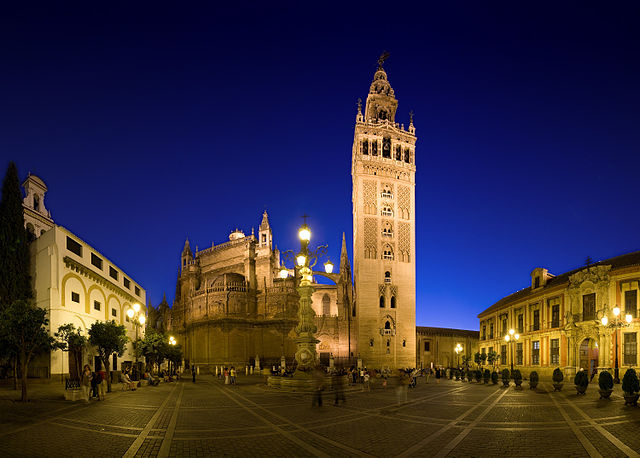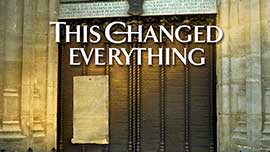EGIDIO RISKED HIS LIFE FOR BANNED DOCTRINES

[Above: View toward Seville Cathedral, newly built when Juan Gil labored there—Photo by DAVID ILIFF. [CC BY-SA 3.0] / Wikimedia File:Plaza Virgen de los Reyes, Seville, Spain - Sep 2009.jpg]
THE SEE OF TORTOSA, Spain, sat vacant in 1550. When Holy Roman Emperor Charles V considered whom to nominate as bishop for the rich and powerful position, he settled on Juan Gil. Gil, who went by the name Doctor Egidio (from the Greek "Egidius" pronounced ih-JID-ih-AHS), was known for both character and learning. Charles V’s favor cost Gil his freedom and could have cost him his life.
A brilliant scholar, Egidio had served as a professor of divinity at Siguenza until appointed preacher (canon-magistral) at the cathedral church of Seville. His sermons were so academic that Seville soon wished it had never heard of him. Rodrigo Valer, a reform-minded evangelist, urged Egidio to preach from the Bible. Egidio listened to this advice and improved so markedly that crowds hung on his words. Among his teachings was justification by faith—a faith demonstrated by Christian obedience. In keeping with this, he poured himself and his resources into charitable works. He preached reform wherever he could get a hearing: in churches, monasteries, convents, and private homes.
Although Egidio’s presentation of the gospel persuaded many priests, friars, monks, and nuns, others grumbled. The Inquisition eyed him as a potential heretic. Still he might have escaped censure if Charles V had not nominated him for the vacant bishopric.
The moment he was nominated, his enemies swooped in with charges, denouncing him to the Inquisition. Imperial favor coupled with rivalries among his accusers undercut the unity of animosity against Egidio. He was allowed to select an arbitrator to examine his position and he settled on Domingo de Soto, a Dominican under whom he had studied.
What happened at the trial is difficult to sort out. Soto claimed afterward that he had saved Egidio’s skin and assured Charles V that Egidio was a good man. However according to a narrative by Gonsalvius, Soto deceived Egidio. He claimed that in their discussions, Egidio and Soto were in complete agreement on justification. At the trial, their podiums were set so far apart that Egidio could not hear Soto because of the distance and the noise of the onlookers. He was supposed to nod in agreement if he accepted each of the Soto’s summary points. Naively, he did so, assuming Soto was stating their agreed points. He then stated his own position which conflicted with what he had just assented to. He was declared guilty and taken to a cell. When friends upbraided him for his inconsistency, he learned Soto had given an altogether different account than when in session with him.
Soto’s defenders say Egidio simply invented the above story to deflect the censure of his friends from his apostasy. However, if he had apostatized, why did his own statement differ from Soto’s? Robert C. Spach, assessing the counterclaims in a 1995 article, says the available evidence largely supports Gonsalvius’s account.* Nonetheless, Egidio must have hidden from Soto the extent of his reform tendencies.
At any rate, when the trial concluded on this day, 21 August 1552, Egidio seemed too bewildered by the outcome to defend himself. The judges condemned him to three years imprisonment, followed by ten years of probation in which he was forbidden to leave Spain. Meanwhile he was banned from celebrating Mass, preaching, hearing confessions, or disputing.
Because prison conditions eroded Egidio’s health, he requested a transfer. He was sent to a nearby monastery in 1553, and later that year he was released. His conversations afterward were mournful and he often rued aloud his former naivete. In 1555 Cathedral authorities must have considered him reliable, for they sent him as their representative on church business to Valladolid. There Reformation converts encouraged him. Feeble from incarceration, he died that same year.
The Inquisition was not done with him, though. Investigating a number of reform-minded Sevillians, inquisitors discovered that all had been Egidio’s disciples. So in 1560 they dug up his bones and burned them, declaring he died as a Lutheran heretic.
—Dan Graves
*Spach, Robert C. “Juan Gil and Sixteenth-Century Spanish Protestantism.” Sixteenth Century Journal XXVI / 4 (1995)
----- ----- -----
The story of the tumultuous Reformation era is told in This Changed Everything. Watch it at RedeemTV.
This Changed Everything can be purchased at Vision Video.







